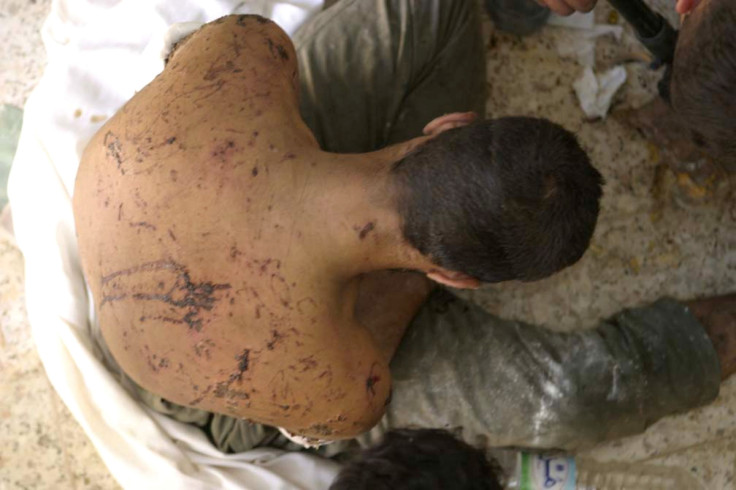International Day Against Torture: 10 Brutal Techniques that Must be Banned [GRAPHIC CONTENT]

The International Day in Support of Victims of Torture, commemorated on 26 June, was designated by the UN in 1945 to raise awareness for the hundreds of victims of torture worldwide.
IBTimes UK looks at some of the most brutal torture methods, still in use today.
Water boarding
The victim is immobilised on an inclined board while a cloth covers their face and nose.
Water is poured over the cloth which allows water to enter in the victim's mouth and nose but prevents it from being expelled. The victim, unable to inhale without aspirating water, experiences the sensation of drowning.
Water boarding was one of the six CIA's approved torture methods during Bush's administration.
In 2002, Saudi Arabian Abd al-Rahim al-Nashiri – accused of having carried out several terrorist attacks – was captured by the US forces and sent to the US base Guantanamo Bay detention facility.
Nashiri was subjected to water boarding by the CIA. In June 2014, a military judge rejected the US government's attempts to keep accounts of the torture method of Nashiri secret.
Sleep deprivation
During sleep deprivation the victim could be kept awake for days at a time.
The technique was used by the British in the 1970s. It is also included in the CIA's approved torture methods.
Saudi citizen Mohammed al-Qahtani – who allegedly tried to enter the US to take part in the 9/11 attacks, was arrested in Afghanistan and transported to Guantanamo in January 2002. He was subjected to sleep deprivation during his interrogation, which lasted over 50 days from November 2002 to January 2003.
Force feeding
The victim is fed against their will through a tube used to inject food into the victim's stomach. The tube is inserted in the nose or in the skin of the victim.
In Guantanamo Bay, prisoners are force-fed when they go on a hunger strike.
Yemeni Emad Hassan (aka Imad Abdullah Hasan) has become the first Guantánamo Bay prisoner to have his claims of abuse at the military base considered by a US court of law in 2014.
Emad Hassan, held without charge in Guantanamo since 2002, claimed he was force-fed more than 5,000 times since 2007 as part of the military's efforts to break his hunger strike, court documents said.
Nail pulling or Denailing
The victim's nails are removed with metal forceps or similar tool.
This torture has medieval origins but, according to International Society for Human Rights (ISHR/IGFM), the technique is still used in China.
The Savak, Iran's secret police until 1979, was believed to use fingernail torture during interrogations.
Cold cell
The victim is left naked in a cell in a temperature of about10 degrees. Throughout their time in the cell the victim is doused with cold water.
This form of torture is one of the six authorised CIA interrogation techniques.
Cold cell was first documented in Mississippi's state penitentiary in 1961.
Electric shock
Body parts of the victim are subjected to electric shocks.
This can cause severe damage to body tissue as well as heart fibrillations.
Amnesty International and Human Rights Watch documented the use of electric shock torture on Egyptian civilians during the 2013 ousting of President Mohamed Morsi in 2013.
The German chair
The victim is placed on a metal chair. Their legs and arms are secured to the metal seat while the back of the chair is pulled back and down toward the ground. This position causes severe and permanent damages to the spine, neck, and other limbs.
This form of torture is believed to be used by the Syrian government against rebels.
Tiger Bench
The victim is placed on a bench and is then tied down so their feet and legs are secured to the bench.
Heavy objects such as bricks are placed under the victim's feet until the legs bend upward and break.
This torture method is allegedly used by the Chinese government against Falun Gong practitioners.
White torture
The victim is subjected to extreme sensory deprivation and isolation in a cell where everything is white and there is no sound.
According to Amnesty International, which documented the case of Amir Abbas Fakhravar, believed to be the first person to be subjected to white torture in Iran, "the cells had no windows, and everything was entirely coloured creamy white. The meal was white rice on a white paper plate. If he wanted to use the toilet, he had to put a white slip of paper under the door of the cell to alert guards who reportedly had footwear designed to muffle any sound. Fakhravar was forbidden to talk to anyone".
This method is believed to be used also in the US.

Strappado
The victim is hung by their arms, which are fastened behind their head, causing the arms to be slowly dislocate from the shoulders.
The latest documented case of strappado occurred in the Abu Ghraib prison, US, in 2003.
© Copyright IBTimes 2025. All rights reserved.






















